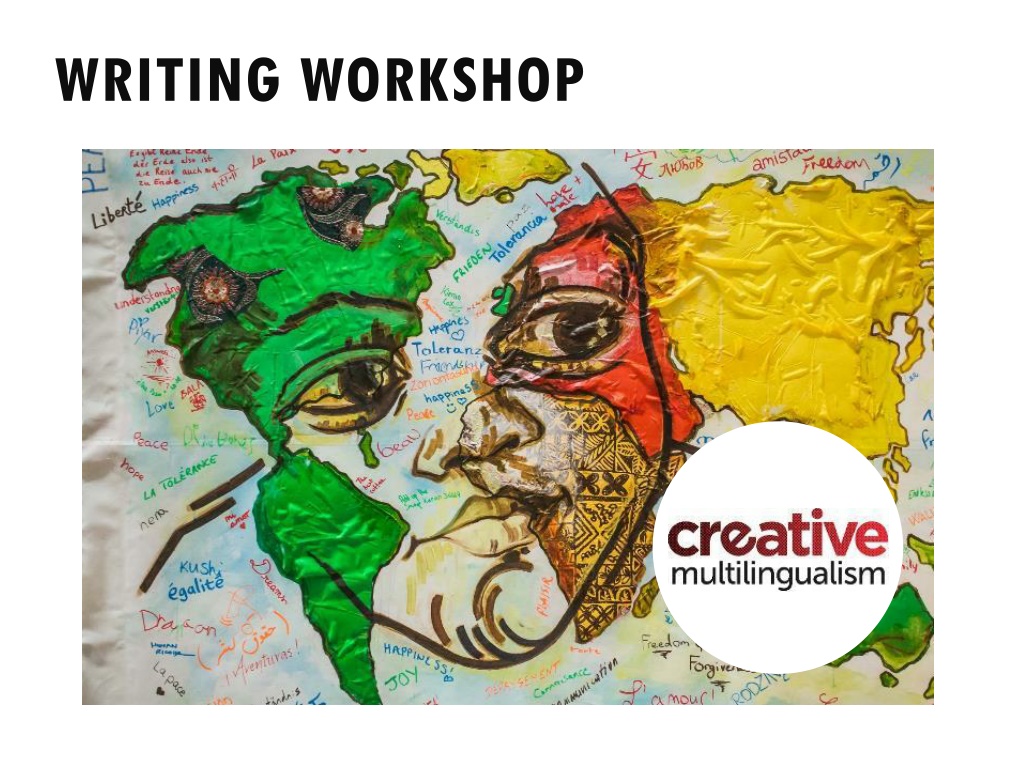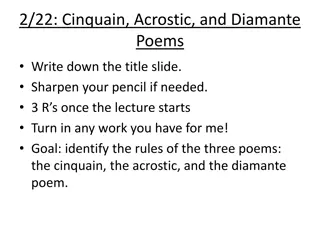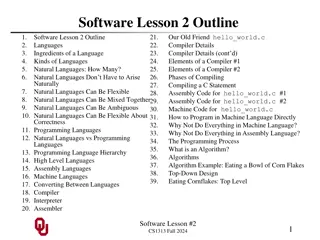Explore Writing Through Cinquains and Haikus in Various Languages
Delve into the art of writing through the structured format of cinquains and the vivid imagery of haikus. Learn how to create these poetic forms with examples in English, Spanish, and French. Discover how haikus can be translated while preserving their form and essence.
Download Presentation

Please find below an Image/Link to download the presentation.
The content on the website is provided AS IS for your information and personal use only. It may not be sold, licensed, or shared on other websites without obtaining consent from the author. Download presentation by click this link. If you encounter any issues during the download, it is possible that the publisher has removed the file from their server.
E N D
Presentation Transcript
CINQUAINS Cinquains: These create a sort of picture with words. The set pattern is Noun Adjective 1, adjective 2 Present participle, present participle, present participle (-ing) Four word phrase Closely related noun or synonym.
EXAMPLE 1: Sarah Noun Slow, tired, Adjectives Sinking, foundering, failing Needs some more sleep Present participles Four-word phrase Granny Related noun
EXAMPLE 2: Happiness Noun Joyful, fun Adjectives Engaging, delighting, attracting Pulls us all in Present participles Four-word phrase Related noun Euphoria.
HAIKU A JAPANESE FORM, ALLOWING YOU TO PAINT A PICTURE WITH WORDS. HAS A VERY CONTROLLED STRUCTURE. 3 LINES, MADE UP OF 5 SYLLABLES; 7 SYLLABLES; 5 SYLLABLES Five syllables here. Seven more syllables here. Are you happy now? The moon lingers on Lighting the frost-covered leaves Making them sparkle. The rainbow spans the blue sky Sun shining, giving Beautiful colours.
HAIKUS EN ESPAOL Mario Benedetti (Uruguay, 1920-2009) Octavio Paz (Mexico, 1914-1998) la mariposa Hecho de aire entre pinos y rocas recordar por siempre brota el poema. que fue gusano no quiero verte por el resto del a o o sea hasta el martes Can be found at: http://adkaplan.blogspot.com/2009/06/haik us-de-mario-benedetti.html (Haikus 15 and 44) Can be found at: https://www.tallerdeescritores.com/ejemp los-de-haiku
HAIKUS EN FRANAIS Jean Paulhan (1884- 1968) Tachibana Hokushi (1665 1718) OR Ozaki Hosai (1885 1926) Bash (1644 1694) La rivi re coule nue Les jeunes arbres vont vivre Dans les bois Parfois, j cris Parfois j efface tout Ainsi, des fleurs de pavot D j quatre heures Je me suis lev neuf fois Pour admirer la lune. [the lines in this haiku don t divide up so evenly but just see it as a sequence of 17 syllables] Can be found at: http://poetia.fr/haiku/la- riviere-coule-nue Fleurs de pavot = poppies
TRANSLATING HAIKUS: CAN YOU KEEP THE FORM AS WELL AS THE SENSE? Un nouveau printemps Coule le flot de la vie Un nouvel espoir Spring is waking up Life flow is running down New hope is coming (Didier Hall p e) pasan misiles ah tos de barbarie globalizados globalised missiles stuffed full of barbarism are passing us by (Mario Benedetti 1920-2009)
ACROSTIC POEMS Teacher to insert Acrostic poems (x2) which are available at: https://mrswattclassroom.weebly.com/acrostic-poem.html
COMBINING YOUR LANGUAGES CREATIVELY Use puns or word play: Dame m s, Dame mash son/ g Use rhyme, rhythm, sound: Moon lune/ chant song cha cha charged with meaning Translate idioms: She doesn t have hairs on her tongue (no tiene pelos en la lengua) I ve got the cockroach (j ai le cafard)
MULTILINGUAL CINQUAIN: EXAMPLE Monday D sol e, d prim e Despairing, despertando, desayunando I ve got the cafard Cockroach
MULTILINGUAL HAIKUS: EXAMPLES Pasan los d as Like a river, rivi re The days pass slowly Esc chame, please Tu m coutes? Je t coute Me escuchas? Gracias.
MULTILINGUAL ACROSTIC: EXAMPLE D antza t nc tan N ssi rin C e (Basque) (Hungarian) (Finnish) (Irish) With me pl E ase
CREATIVE WRITING Try writing a Cinquain, a Haiku or an Acrostic, using as many languages as you like. OR Write a poem like My Language by Kumari Tarapatla, using a repeated phrase or a regular rhythm: Teacher to insert poem here. Can be found in: Brave New Voices, A city imagined. https://www.englishpen.org/outreach/brave-new-voices- 2-0-year-one/#read-bnv OR Invent your own form! It doesn t have to be regular.
"The image and sound of Multilingualism" by The Language Project https://www.youtube.com/watch?v=MM6Zlr_x-zM
BENJAMIN ZEPHANIAH Image (unchanged): Edwardx [CC BY-SA (https://creativecommons.org/licenses/by-sa/4.0)]
THE BRITISH Teacher to insert poem here. Can be found at: https://benjaminzephaniah.com/rhymin/the-british-serves-60- million/
EDWARD KAMAU BRAITHWAITE Image available for classroom use at: https://www.theguardian.com/books/202 0/feb/05/edward-kamau-brathwaite- obituary
THE AWAKENING Teacher to insert poem here. Can be found in: The Arrivants: A New World Trilogy. Edward K Braithwaite Published by OUP Oxford, 1981 ISBN: 9780199111039
DALJIT NAGRA Image (unchanged): Simon James [CC BY-SA (https://creativecommons.org/licenses/by-sa/2.0)]
RAPINDER SLIPS INTO TONGUE Teacher to insert poem. Can be found at: https://www.poetryinternational.org/pi/poem/19356/auto/0/0/ Daljit-Nagra/RAPINDER-SLIPS-INTO-TONGUE/en/nocache Video Version: (Intro until 00:38) https://www.youtube.com/watch?v=EBGYSchCfII























